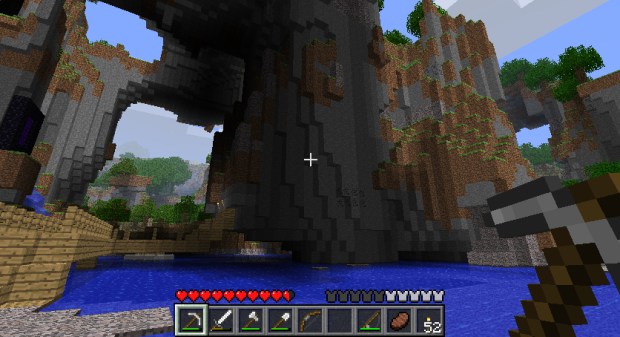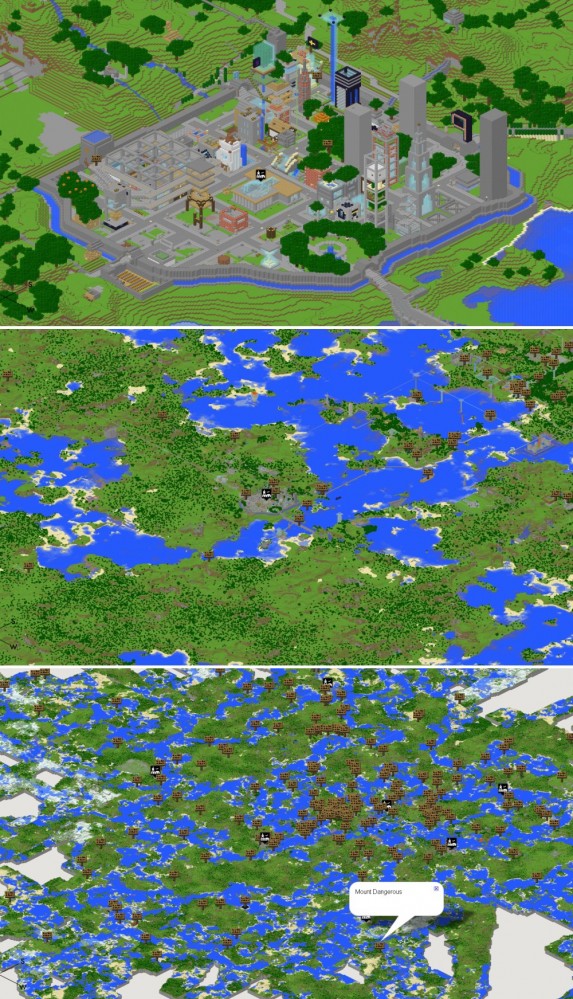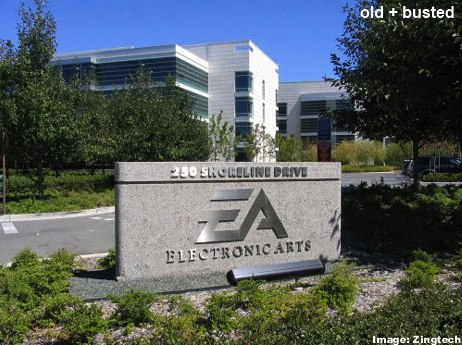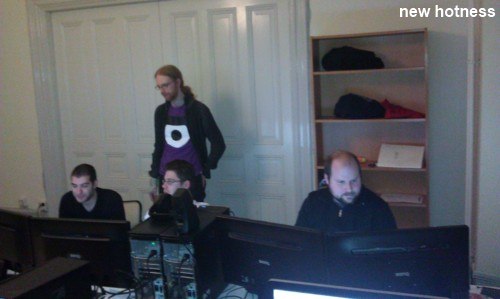
On Wednesday, it was announced that a game called Minecraft had hit a million sales. This probably isn’t the first time that you, a denizen of the internet, have heard that word. But unless you’re in the habit of following up on every indie game mention you happen to see, there’s a good chance this particular title might have slipped under your radar. So what is Minecraft, and why is everyone talking about it?
What it is
The game itself, which you buy and download directly from Minecraft.net, is in what some call the Sandbox genre. It means that you’re given free rein in a world where there is little or no plot to drive gameplay; the gameplay emerges from the tools and the world you’re in. In a way, popular games like Grand Theft Auto and Fallout 3 are sandbox games despite overarching narratives, and Second Life was an attempt to make community-driven sandbox world. Minecraft takes it a step further: the entire world is generated from scratch, and all you start with are your own two hands — blocks, rather.
 See, that’s the other thing about Minecraft. It has a visual style that both arrests the eye and allows for unique gameplay: the entire world is made up of blocks of various types: dirt, cobblestone, obsidian, lava, water. And you can combine these blocks to create tools, machines, doors, and so on. Use stone to create a furnace, and use the furnace with the coal you mined to fuse sand into glass, or make clay into tile.
See, that’s the other thing about Minecraft. It has a visual style that both arrests the eye and allows for unique gameplay: the entire world is made up of blocks of various types: dirt, cobblestone, obsidian, lava, water. And you can combine these blocks to create tools, machines, doors, and so on. Use stone to create a furnace, and use the furnace with the coal you mined to fuse sand into glass, or make clay into tile.
And of course you need metal, which doesn’t just lie around: Minecraft’s procedurally-generated worlds imitate the real ones in that ore is rarely found above ground, and you must dig or explore huge natural cave systems to collect the iron, gold, diamond, and other elements. There’s even “redstone,” which acts as an electrical signal carrier, and, combined with the simple logic of switches and delays, has led to elaborate productions like this working 8-bit CPU simulated within the simulated world. New and interesting projects like Kinect hacks and Rube Goldberg machines are being made literally every day. One server is building a scale model of the Vatican.
Combine all this natural variety with a day/night cycle, roving monsters, and essentially an endless landscape (one collaborative world I’ve explored, Aporkalypse (right), must span the equivalent of a hundred square miles), and you have perhaps the most open-ended sandbox game ever created. To truly understand the draw, you have to try it, maybe watch a few tutorial videos, and explore the community. But so much for the game’s considerable charms.
Why it matters
Sounds interesting, you say, but why should I care that a few guys have put together a cool little indie game? The reason you should care is because a team of four or five people using free libraries and cross-platform tools have just made a mockery of the last five years of franchise-oriented, $50 million budget, yearly-release, AAA game development. And it’s not just a fluke. The Humble Indie Bundle, World of Goo, Braid, and a number of other extremely low-budget titles have electrified the gaming community, while games with millions in marketing budget like APB and Kane & Lynch fall flat on their face critically and commercially. Gamer discontent with these barren blockbusters is palpable, and Minecraft is the new poster boy for it.

The game isn’t technically finished; in fact it only recently left pre-beta state. It’s buggy, missing major features, and to make things brief, you kind of have to want it. But it also doesn’t have B-movie voice acting, a scruffy 30-ish white protagonist, DLC, a movie deal, console exclusivity, or any of the other hundred things that plague gamers in practically every major release. Notch (Markus Persson), Minecraft’s main developer, was in the right place at the right time with the right product: a vehemently anti-commercial game that emphasizes creation, community, and ingenuity. Oh, and did I mention it’s cheap, you got all future updates for free, and it’s cross-platform? (Update: I should have been more clear: Alpha buyers got all updates for free, but now that the game has entered beta, that is no longer the case.)
The business model he chose sounds like suicide: develop on spec, release an unfinished product, let it promote itself and trust the community. At least, that sounds like suicide to a producer at EA or Take Two. But to an internet entrepreneur, it’s as familiar as mom’s apple pie. Not long ago, the big releases in the software world were the latest from Adobe or Microsoft — now we are seeing a bottom-up trend that’s totally disrupting that model. Sure, we all still need Word and Photoshop, but what about things like Word Lens? They’ve probably got a line out the door making offers. It’s true, they’re working with tools developed by millions of dollars in research by Apple and Google, but few tools (like the Java and GPL libraries used by Notch) are really built from zero at the moment. Shoulders of giants, and all that.

It wasn’t until recently that game development could truly be said to be democratized, if it even is today. The need for specialized equipment, access to dev kits and internal code libraries from Sony and Nintendo, huge art budgets and so on is dissolving. And with lower costs and personally motivated developers come not only lower prices but, some say, better games. Braid and Minecraft are both examples of how a few good ideas, executed in an accessible and affordable way, will outsell franchises by orders of magnitude.
With gaming threatening to unseat cinema and TV in terms of time and cash invested, this change from a top-down to a bottom-up development process isn’t just a curiosity, it’s a momentous change. The time has come when not only are the tools for creation available to the dedicated independent developer, but also the means of distribution and popularization. The heavy hitters in the industry will find themselves much more under threat soon from the proverbial two guys in a garage. Minecraft’s success may seem a lark born of big-budget backlash and social media, but pretty soon, that kind of success won’t be a lark, it’ll be a back door to a billion-dollar market.